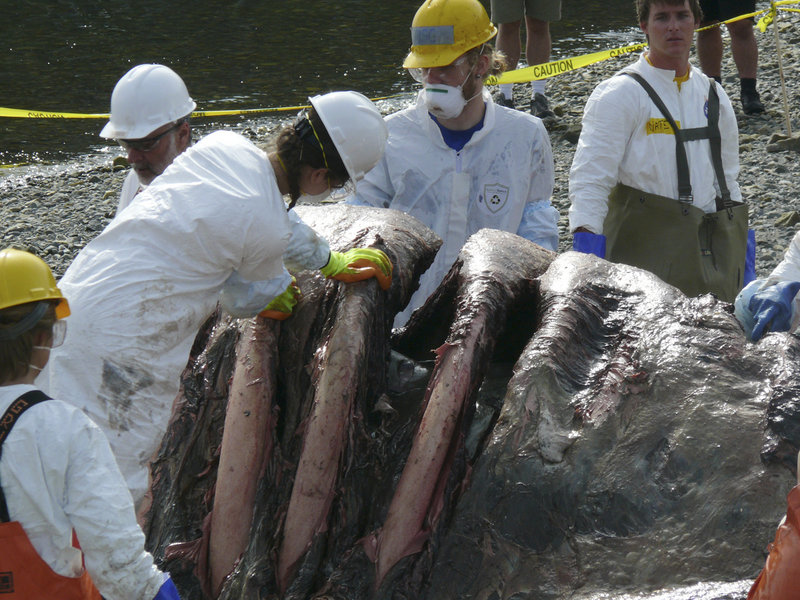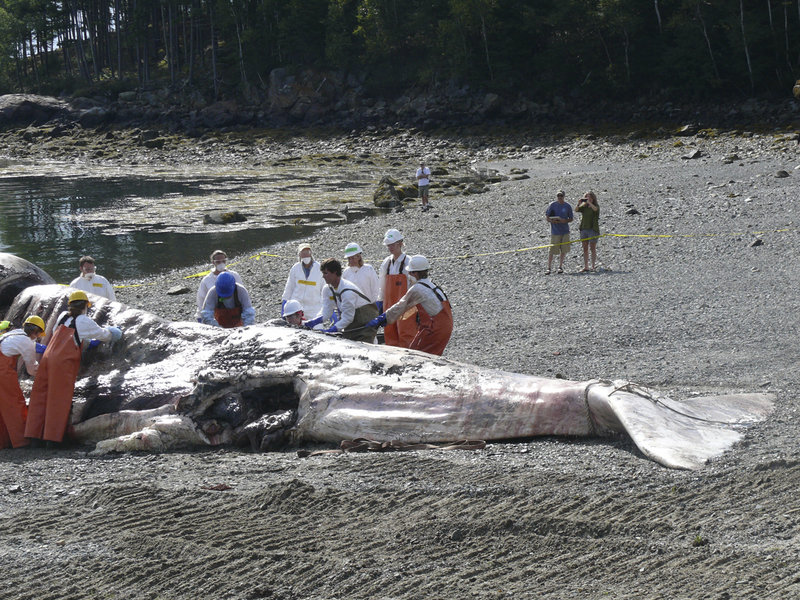A sperm whale carcass, retrieved last week from Frenchman Bay, was dismembered as part of a necropsy of the gigantic marine mammal conducted Monday by researchers near Bar Harbor.
It could take seven to eight months to compile results from the necropsy, said Sean Todd, director of Allied Whale, College of the Atlantic’s marine mammal research group. The college, marine sciences students, volunteers and other scientists participated in the procedure.
Marine scientists might never know what caused the whale’s death, said Todd, who was coordinating the gargantuan effort of sectioning off portions of the carcass for study.
The whale — a 10- to 15-year-old male weighing 50 tons and measuring 50 feet long — was found dead, floating in waters off Acadia National Park, by a fisherman on Aug. 13. The next day it was towed in by the College of the Atlantic’s new utility, transport and research vessel. It was dragged tail first, “very slowly” to a private beach, said Donna Gold, director of public relations for the environmental liberal arts college in Bar Harbor.
The effort to determine the cause of death took all day Monday, said Gold. The remains were then taken to a privately owned burial area, where, she said, “we will let the worms and bugs feast on them. And then it’s ready for us.”
That should take 10 to 12 weeks, and even after lengthy burial, the bones will need to be boiled to further clean them.
“It’s a massive operation; it smells pretty strong,” Todd said by phone from the site of the work, which started at 10 a.m. and was aided by operators of a backhoe, roll-off loader and several flatbed trucks. “We got through the really gross part,” he said, adding that the odor diminished as the day wore on and the process continued.
The necropsy involved severing the whale’s head, weighing about 30,000 pounds, from the body for study, and then cutting the remaining 70,000-pound trunk-to-tail portion into smaller pieces to make it easier to haul away.
Allied Whale, which is part of the Marine Mammal Stranding Network, is operated by the National Oceanic and Atmospheric Administration. The program, which extends from Rockland to the Canadian border, intends to “collect as much scientific information as possible” and to reconstruct the skeleton for display at the Bar Harbor Whale Museum, said Todd. The impressive skeleton will be used to raise money for the museum and attract new donors.
“I am guilty of using whales as poster children to talk about marine conservation,” Todd said. Humans “haven’t done a terribly good job” of managing the world’s oceans, and to get the conversation going about how better to do that, he said, “nothing grabs the attention like a 50-foot carcass.”
The bones were in “extremely good condition,” which pleased marine scientists and researchers, because the intact skeleton constitutes an extremely rare and valuable find, Todd said.
The scientists and other workers created teams of four to six people for the necropsy, and two teams at a time worked on the carcass, Gold said. They had to cut through substantial fat on the carcass, which had been decomposing for about two weeks, before reaching a muscle layer 1 foot thick.
Sperm whales are not only among the largest animals on Earth, they are also an uncommon sight — particularly in the Gulf of Maine. The great whaling fleets of the 18th and 19th centuries hunted down whales in vast numbers, particularly sperm whales, decimating migrating populations almost to extinction.
These bizarre-looking whales — dark brown or blue to pale gray with a roughly square profile, dorsal hump and wrinkled appearance on the sides — have the largest brains of any creature in the world. They are capable of diving up to 2 miles beneath the ocean’s surface. In this dark, murky world, sperm whales, which also are the largest toothed animals on the planet, hunt upside down, researchers have learned. This behavior suggests that they might be seeking out the forms of squid — their favorite prey — against the faint light penetrating the sea from above.
Their range covers virtually the entire globe, and the whales can be found from the equator to the edge of pack ice at the farthest extremes of the oceans in both hemispheres.
Within their enormous “nose,” or head, they have a cup-shaped skull partly filled with a milky-white waxy substance — spermaceti — that can vary in temperature enough to be transformed from an oily substance to a hardened wax. By means of this change, the sperm whale is able to match the density of water at great depths.
The structure of the head, which alone weighs one-and-a-half tons, is a sign that the whale — which has keener hearing than vision — likely possesses an intricate system of echolocation. A kind of biological sonar through which it emits a series of clicks and listens for the return of the sound waves, echolocation is the principal weapon in the sperm whale’s arsenal for locating prey.
From the 18th to 20th centuries, these whales were savagely hunted for their spermaceti, used for candles, soap and cosmetics, as well as ambergris from the intestines for fine perfumes. Even now, they are listed as endangered by the International Union for the Conservation of Nature.
Staff Writer North Cairn can be contacted at 791-6315 or at:
ncairn@pressherald.com
Send questions/comments to the editors.




